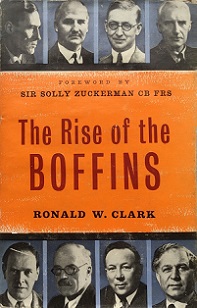
The Rise of the Boffins
Phoenix House Ltd, 1962, Ex library but minimal stamps, firm binding, no foxing noted, dustwrapper worn but intact, covered for protection, small chips repaired.
Victory in the last war was largely due to the fact that Britain eventually used her scientific potential more efficiently than her enemies did. Was this by planning or by chance? Was it a by-product of Britain's long record of pure research? Was it a result of a native tradition of compromise which enabled scientists and servicemen to work together with an ease which eluded the enemy? Or was it, perhaps, the outcome of efforts by a few individuals? The author has had the help and cooperation of many important scientists on whose work the Services have depended and he has interviewed many of those responsible for using the scientific results in battle. He has been granted access to the archives of the Royal Society and has been able to consult much fresh material elsewhere. Included here is a detailed account of the long detective trail which led to the discovery of the first German navigational beams - found leading to Derby, home of the vital Rolls Royce engine works. Also, an account of the bizarre `battle of the beams' which followed, and was fought out during the autumn blitz in which Coventry, Birmingham and other Midland cities as well as London were heavily raided. Here is the story of how a small `private army' of scientists directed by Sir John Cockcroft helped to protect Scapa Flow by setting up radar on Fair Isle, and how Professor Andrade stood in the `death ray' to prove that it wouldn't work. The story of how the cavity magnetron, which was to have such immense repercussions on the war, was developed in Birmingham University is also told. With a forward by Sir Solly Zuckerman...
